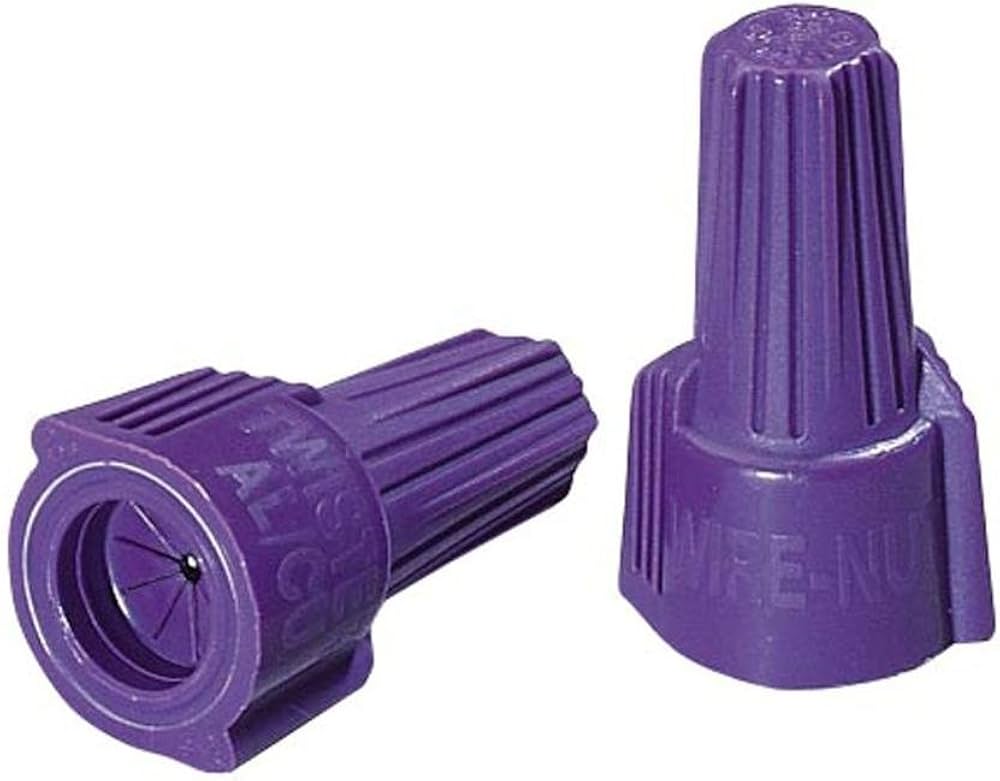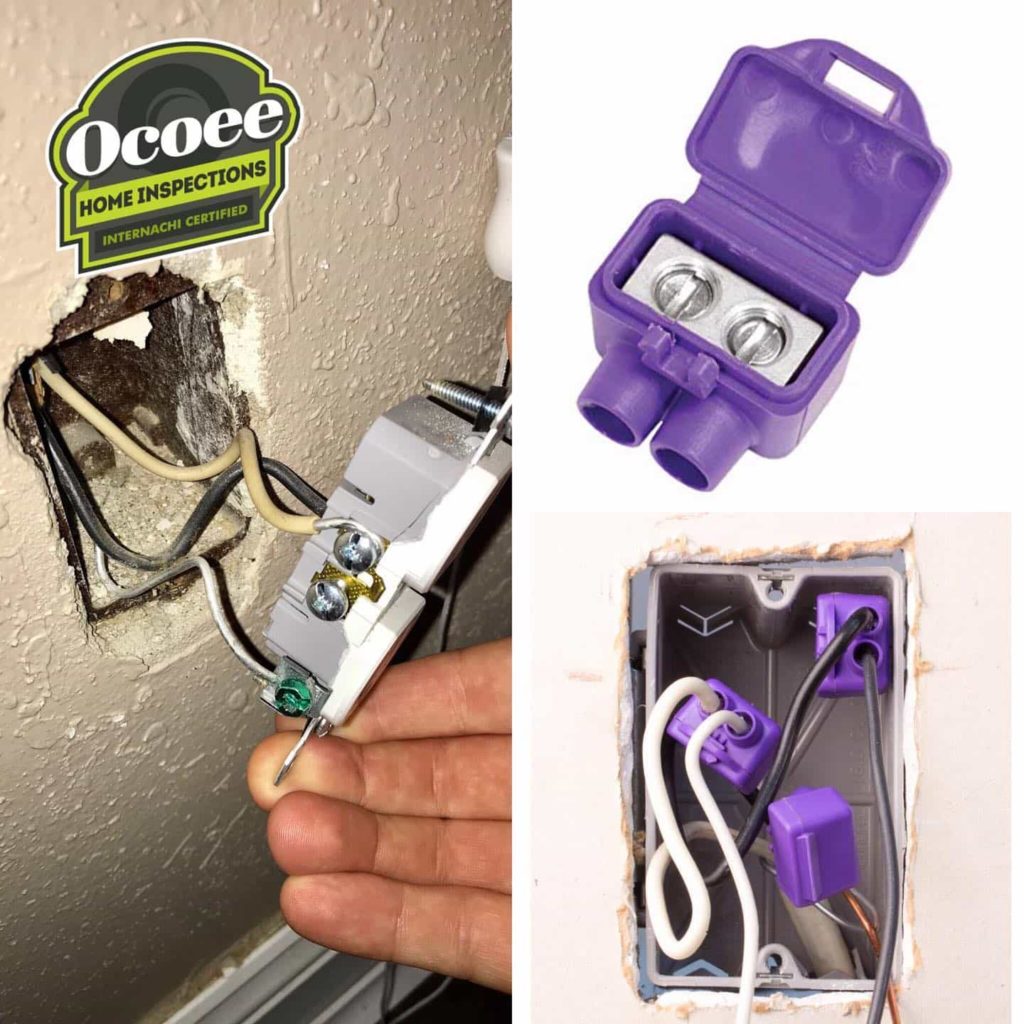If you are shopping for new home insurance you may run into issues if you have purple wire nuts on your aluminum wiring. Although these are approved by the Underwriters Laboratory and accepted in the NEC they are not accepted by most insurance companies here in Florida. The most accepted forms of remediation are with Alumiconn and/or Copalum connectors. Citizens Insurance is known to be the carrier of “last resort” and even they do not accept them.

Why insurance companies have issues with purple wire nuts

Purple wire nuts have a high rate of failure and that is why insurance companies tend to stay away from them. The issue with the design is that it does not separate the copper and aluminum wires like the others do. Copper and Aluminum expand at different rates when heated which can cause increased resistance. High resistance in wiring causes heat which can lead to a fire. Since release there have been independent studies done on the the use of these as a form of remediation.
PIGTAILING USING IDEAL #65 “TWISTER” CONNECTOR
After about 1987, when UL adopted a revised standard (UL486C) applicable to twist-on connectors for aluminum wire, twist-on connectors were no longer being marked (in the USA) as UL listed for aluminum wire applications. In 1995, UL accepted a twist-on connector – the Ideal #65 “Twister” – for aluminum-to-copper wire combinations, including those commonly used in the “pigtailing” retrofit. The Ideal #65 has been heavily promoted for that application. The connector is
essentially the same as twist-on connectors that had performed poorly in previous testing, the major difference being that it is prefilled with inhibitor compound. Based on its construction, there is good reason to question the long-term performance of the Ideal #65. Because of its UL listing, however, most electrical inspectors would accept this connector for pigtailing of aluminum wiring.
As soon as it appeared on the market, the Consumer Product Safety Commission (CPSC) questioned UL’s listing of this connector for the aluminum wire pigtailing wire combinations. Although the manufacturer claims that the connector has been thoroughly tested for the application, neither the manufacturer or UL have released any substantive test data. The manufacturer states that the connector has received CSA certification for the same wire combinations. Information developed so far indicates the following:– The manufacturer is no longer claiming that the connector is intended for use in the pigtailing retrofit application. Instead, the manufacturer now states (to CPSC) that the Ideal #65 is intended for such applications as connecting lighting fixtures and ceiling fans. Ideal has committed to CPSC to change its advertising and instructional information accordingly.
– UL did not independently perform the “heat-cycle” life tests required by their standard. These tests were performed by the manufacturer, with UL accepting the manufacturer’s results.
– The connector was not “heat-cycle” tested for the common pigtailing wire combinations with current passing through the aluminum-aluminum wire path
(in an aluminum-aluminum-copper splice).– The “heat-cycle” tests that were performed by the manufacturer on the Ideal #65 “Twister” connector were not done using aluminum wire of the type actually installed in homes built in the 1960’s and early 1970’s.
– The CSA certification was based on UL’s acceptance for listing. CSA did not independently evaluate the Ideal #65 connector. In fact, the use of a zinc-plated steel spring in the connector violates a CSA general requirement for connectors for aluminum wiring. CSA is re-evaluating the certification of this connector and may now do its own testing.
– Both the plastic insulator of the connection and the inhibitor compound inside the connector ignite readily and burn freely. This increases the chance of fire ignition if connection failure occurs.
Independent testing of the Ideal #65 “Twister” has demonstrated the following:
– Installed according to the manufacturer’s instructions (without abrasion or pretwisting), the connector does not reliably establish low-resistance connections. (This finding contradicts the manufacturer’s claim that particles in the inhibitor inside the connector serve to abrade the wire and eliminate the need for separate abrasion of the wires.)
– The Ideal #65 connector does not consistently pass the UL “heat-cycle” test requirement when tested with aluminum wire of the type actually installed in homes with current passing through the aluminum-aluminum path in a pigtailing (aluminum-aluminum-copper) splice.
– The performance of the Ideal #65 Twister is essentially the same as that of poorly-performing twist-on connectors previously evaluated for the aluminum wire pigtailing application.
Approved methods for aluminum wiring remediation


If your home has single strand aluminum you may be required to have “remediation” done to get home owners insurance. As mentioned before the only two types of connectors are Alumiconn and Copalum connectors. An electrician will need to install these at every outlet and light fixture. Due to the size of the alumiconn connectors they may also need to install larger junction boxes for the outlets. The current rate for an alumiconn connector sold in bulk is going to range from $3-$4. Each outlet will require 3 connectors(one for hot, neutral & ground) so you can see how this can get pretty expensive depending on the size of the home.
If your home has older aluminum wiring and you would like to have it inspected be sure to call us at 407-633-1661 or book online.

